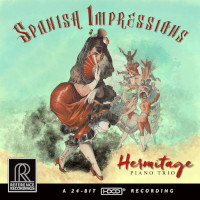Review by Colin Clarke
SPANISH IMPRESSIONS • Hermitage Pn Tr • REFERENCE 151 (68:44)
ARBÓS Trois Pièces originales dans le genre espagnol, op. 1. TURINA Piano Trio No. 2 in b, op. 76. CASSADÓ Piano Trio in C. PERELLÓ Tres Impresiones
There are revelations galore from this trio of musicians who, although none of them are actually from Spain, are all fascinated by the region and its music. That enthusiasm permeates this fascinating disc. It is unlikely that all four works will be familiar to many, so it is good that Reference Recordings has provided a long and detailed English-only booklet, with thorough biographies of each of the four composers and detailed descriptions of the works involved. The Hermitage Piano Trio comprises Ilya Kazantsev, piano; Misha Kelin, violin; and Sergey Antonov, cello.
The journey begins with a piece known in English simply as Three Spanish Dances by Enrique Fernández Arbós (1863–1939). Christmas Day-born Arbós studied violin in Brussels with Vieuxtemps (for four years) and composition with Gevaert; a fellow student of Gevaert’s was one Isaac Albéniz, and Arbós and Albéniz became firm, lifelong friends. Arbós moved to Berlin, studying violin with Joachim and composition with Heinrich von Herzogenberg. Later, he was to become concertmaster of the Berlin Philharmonic, the Glasgow Orchestra, the Boston Symphony, and later at Winnipeg. His conducting side took him to St. Louis and on tour with that city’s orchestra to London, where in 1891 he was appointed to the Royal College of Music. Although he concentrated thereafter on conducting, he also formed a piano trio.
The Trois Pièces orginales dans le genre espagnol (1886) is a masterpiece. This is Arbós’ op. 1, and what a way to get going. The three pieces make a satisfying whole, and all three are suffused with the spirit of Spain. The Hermitage Piano Trio members understand the importance of the fundamental rhythms, but also project the depth of this music’s rich tapestry of themes and their handling. The outgoing “Bolero” is followed by a slinkily seductive “Habanera” and beautiful “Seguidillas gitanas.” Robust on the outside, it contains passages of melting beauty. Pianist Ilya Kazantsev’s articulation is miraculous, while Misha Keylin and Sergey Antonov work beautifully together in parallel lines.
Back in 2005, Jeffrey J. Lipscomb reviewed an all-Arbós disc on the Verso label (Fanfare 29:2). That disc usefully presents all of the composer’s chamber works, with the op. 1 performed by the Trio Bellas Artes. It’s a useful space for further exploration for sure, but the performance of the Trois Pièces is no match for that of the Hermitage Piano Trio. The recording is not as focused, and while the Trio Bellas Arts give the idiom a good go, it is the Hermitage players that transcend the studio confines (their disc was recorded in April 2023 in Marin County, California).
The Hermitage Piano Trio is no less impassioned in Turina’s Piano Trio in B Minor, op. 76, of 1932–33. This wonderful, emotionally complex piece opens with an extended first movement that is far more than just the Lento of the movement listing; the form is carefully considered and satisfying, especially in a performance such as this one that grasps all the elements. The spectral central Molto vivace finds both string players active (almost hyperactive) in this 5/8 Scherzo before a multivalent finale closes this fine work. This finale moves from Lento through a waltzy Allegretto before a chorale-like Moderato followed by an Allegro vivo ending. The understanding of the Hermitage Piano Trio of how this movement works is beyond compare.
That said, competition here is obviously high, with the Beaux Arts Trio on the scene (they offer the Piano Trio No. 1 plus some Turina and Granados). In repertoire terms, though, it is a disc on the Avi label that intrigues, coupling the Turina with works by Frank Martin (Piano Trio on Popular Irish Tunes) and the ever-fascinating Bulgarian composer Pancho Vladigerov’s Piano Trio in B♭ Minor.
Moving on to Gaspar Cassadó’s Piano Trio in C Major (1926), we find another flavor of Spanish expression again, one that is shadowy (don’t let that C-Major key fool you). Its placement on this program is perfect (it reappears in a similarly intriguing program by the Devich Trio on Challenge Classics, coupled with Turina, Granados, and Arbós, reviewed by Jonathan Woolf in Fanfare 34:6). The Hermitage Trio offers properly unbuttoned playing. Both the work and the Hermitage performance of it brim with energy. Cassadó’s handling of rhythm and melody is a wonder, while his writing in the central Tempo moderato e pesante will certainly raise an eyebrow or two. This is daring on a compositional level, and how the Hermitage players allow us to enjoy the spirit of adventure. Keylin’s violin sings in this movement, and Antonov is no less expressive in his responses. Interpretively, the group’s ability to take its time and relish Cassadó’s often intriguing thought processes trumps any other performance. There is charm aplenty here (listen to Kazantsev’s way with the melodies of the finale). In a disc of high points, this piece is a real highlight. It is unsurprising that the cello has much to do, given Cassadós’s fame as a cellist (he performed chamber music with the likes of Yehudi Menuhin and Bronislav Huberman).
Chandos claimed the first recording of Cassadó’s Trio when it released the Bekova sisters’ performance (Fanfare 25:1) and although there are now several more, it is fair to say that I am tethered to the Hermitage performance.
Finally, there comes a piece by the Catalan composer Mariano Perelló (1886–1960), his Tres Impresiones of 1922. A famed violinist, Perelló was part of the Trio Barcelona (whose pianist was Ricardo Viñes, no less, to whom the Impresiones is dedicated; the cellist was Joaquim Pere Marés i Gribbin). The Trio Barcelona programmed the Impresiones from the work’s inception—and what a beautiful set of three pieces this is. The charm of the initial “Pensando en Albéniz” (Thinking of Albéniz) is absolutely captivating here, while the Andalusian-style “Capricho Andaluz” that follows is a teasing dance fantasy, unique, captivating on every level and at each moment. The finale is “Escenas gitanas,” a gypsy invocation, specifically of gypsies from Granada. Teasing, evocative, sultry, it is all these things and more.
Astonishingly, this is Perelló’s first listing in the Fanfare Archive; may it not be his last. There is an alternative performance of the Tres Impresiones, however, by the Trio Salduie, sadly marred by a close and dry recording.
So, top of the tree for all four works on this recording. Documentation is way beyond criticism for content; the recording is faultless, as is the playing. A very special disc and one henceforth shortlisted for my 2024 Want List. Colin Clarke






















